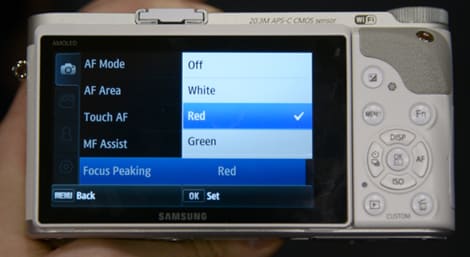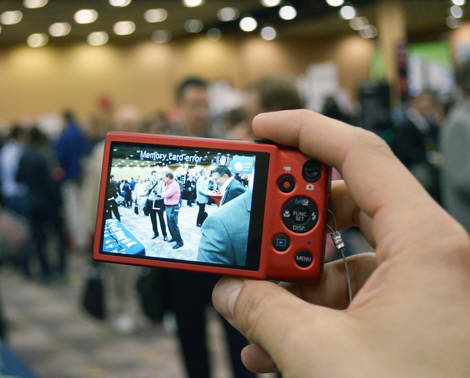Introduction
Design & Appearance
{{section_header}}{{section.name}}{{/section_header}}
The EX-ZR15 has a 7x optical zoom lens that telescopes out of the body when the camera is turned on. The design gives the camera a very compact body despite its zoom range. The camera has a two-tone design with a black back and a slick plastic faceplate. The ZR15 has the same rear control design as the EX-ZR200, with the only major differences being the lack of a rubberized front grip, smaller lens, and a top plate that include a "best shot" and "auto" button instead of a physical mode dial and "high speed" button.
Tour
{{section_header}}{{section.name}}{{/section_header}}




Menu
{{section_header}}{{section.name}}{{/section_header}}
The EX-ZR15 has the same menu as the EX-ZR200, except for the specific features that the higher-priced ZR200 includes that the ZR15 does not. The menu is laid out with three horizontal tabs, each containing a group of options arranged in a multiple-page list. It's not an ideal menu system, as it leaves several options hidden offscreen, yielding a higher learning curve as you sometime have to search through multiple pages to find the option you're looking for.
Ease of Use
{{section_header}}{{section.name}}{{/section_header}}
The EX-ZR15 is easier to use than the EX-ZR200, by virtue of a dedicated auto button to go along with pared down controls with a focus on automatic shooting. The ZR15 does not have a physical mode dial, however, which makes switching between modes a little harder. Instead of the mode dial, users have to use the "BS" best shot dial, which brings up a selection of scene modes for the user to pick from.


Size & Handling
{{section_header}}{{section.name}}{{/section_header}}
The EX-ZR15 is a 7x optical zoom camera that slots into your pocket. Unfortunately it lacks any sort of rubberized material on the front, though this is typical of compact point and shoots.


Modes Overview
{{section_header}}{{section.name}}{{/section_header}}
The ZR15 lacks a physical mode dial, but it does feature the automatic features you'd expect on a typical compact point and shoot. It does, however, feature the premium auto pro mode from the ZR200, choosing automatically from a selection of best shot modes that adjust exposure to evenly distribute brightness (depending on the metering and scene mode selected). In order to access the different modes on the camera manually, you simply press the "BS" button on the top of the camera, bringing up the "best shot" selection screen where you can select from up to 39 different modes.

Auto Mode
{{section_header}}{{section.name}}{{/section_header}}
Pressing the "best shot" button brings up the EX-ZR15's version of mode selection, with 39 different options. These range from HDR and HDR art to high speed night scene modes, though there's no mode that allows for manual exposure control. If you just want to get a basic automatic exposure mode without any particular scene in mind, simply press the auto button on the top plate for the camera to revert to regular shooting.

Movie Mode
{{section_header}}{{section.name}}{{/section_header}}
The EX-ZR15 has full 1080p HD video recording, in either 30 or 15fps options. Users can also shoot in 720p, VGA, and high speed video modes. The ZR15 does not have the 1000fps video of its more expensive cousin the EX-ZR200, but it does have 480fps (224x160), 240fps (512x384), 120fps (640x480), 30-240fps (512x384), and 30-120fps (640x480) modes.
Drive/Burst Mode
{{section_header}}{{section.name}}{{/section_header}}
The EX-ZR15 has a full range of drive and burst modes, with the ability to take still images at up to 30fps and full-resolution. The camera's many scene modes are also chockablock with different ways to take advantage of that level of speed. The camera can use multiple near-simultaneous images to combat a lack of zoom, camera shake, subject movement, low light, and other obstacles. The results aren't always perfect, but they work. The camera also has a self-timer with the option for a 10- or two-second delay, with an option to fire three shots after a delay for group portraits.
Playback Mode
{{section_header}}{{section.name}}{{/section_header}}
The Casio EX-ZR15 includes a standard amount of playback control, with the ability to zoom in on images or zoom out to view an index of multiple image thumbnails. Users can also delete, resize, rotate, trim, protect, or change the white balance and brightness of an image. Casio has also included their dynamic photo option, which allows you to insert a number of frames, animations, etc. into a photo on your memory card.
Picture Quality & Size Options
{{section_header}}{{section.name}}{{/section_header}}
When taking photos on the ZR15, users can take a full 16-megapixel image in almost every shooting mode. There are also options to restrict the size of a taken photo, with options for capturing 16-, 14-, 12-, 10-, 5-, 3-, or 0.3-megapixel images. You can capture JPEG images in either normal or fine compression, as well, letting users fit more shots on a single memory card.
Focus
{{section_header}}{{section.name}}{{/section_header}}
Focus can be achieved on the EX-ZR15 in the form of autofocus, infinity, macro, and manual focus modes. Users can then select a focus area, with options for spot, intelligent, or subject tracking focus types. Whenever using autofocus, the camera only has a contrast-detection AF system available, which is normal for a point-and-shoot camera. When light gets low an AF lamp is included to add just a little more light.
Exposure & Metering
{{section_header}}{{section.name}}{{/section_header}}
The EX-ZR15 does not include the option to manually set exposure (or even prioritize a particular shutter speed/aperture setting), though it does include center-weighted, pattern, and spot metering measurements via the image sensor. The camera will automatically choose a shutter speed from between one and 1/2000th of a second, though it can take a four second exposure in the night scene mode.
ISO
{{section_header}}{{section.name}}{{/section_header}}
The EX-ZR15 has an ISO range of 80-3200 available to users. Users can choose any of the full-stop speeds in addition to the low setting of 80. There's also an option to let the camera automatically select the appropriate sensitivity, though there's no control over what settings the camera can choose from.
White Balance
{{section_header}}{{section.name}}{{/section_header}}
There are six white balance presets available on the Casio EX-ZR15, including daylight, cloudy, two fluorescent settings, tungsten, and overcast. You can also let the camera just automatically detect color temperature, or take a manual reading of a white or neutral card to establish white.
Image Stabilization
{{section_header}}{{section.name}}{{/section_header}}
The Casio ZR15 has optical stabilization by virtue of its CMOS shift stabilization, which will correct for shake by physically moving the sensor to counteract movement. The camera also has a high speed anti-shake mode, which takes multiple images and combines them to try and form a single sharp image. Anti-shake can be turned off in the menu, which is recommended if you're shooting on a stable surface or tripod.
Picture Effects
{{section_header}}{{section.name}}{{/section_header}}
There are a couple of different types of picture effects available on the ZR15. The camera only has a basic color filter option in the main menu, though the "best shot" scene modes can impact a picture more dramatically. In playback users can take advantage of the pretty wild "dynamic photo" options, which place animated pre-rendered characters and frames on a previously captured image.
Lens & Sensor
{{section_header}}{{section.name}}{{/section_header}}
The Casio EX-ZR15 features a 7x optical zoom lens, with a maximum aperture range of f/3.0-5.9. The camera has an actual focal length of 5-35mm, with an approximate 35mm equivalent of 28-196mm. The camera captures images via a 16.1-megapixel CMOS image sensor, putting it in line with the more expensive EX-ZR200.

LCD
{{section_header}}{{section.name}}{{/section_header}}
The rear LCD on the EX-ZR15 is a 3-inch TFT-LCD with a 461k-dot resolution. The LCD is fairly high resolution, enough at least to provide the ability to accurately judge focus and image detail. The screen is bright enough for use in most situations, though we weren't able to test its usefulness in bright sunlight.

Flash
{{section_header}}{{section.name}}{{/section_header}}
The flash on the EX-ZR15 is built into the body, with a range of 5.2 meters (at the wide angle), identical to the EX-ZR200. That shrinks to just 2.6 meters when zoomed all the way in, though you can extend that by turning up the ISO sensitivity on the camera.

Jacks, Ports & Plugs
{{section_header}}{{section.name}}{{/section_header}}
Remove a small plastic port on the right side of the EX-ZR15 and you'll find a mini-HDMI and proprietary USB/AV port. The camera's connectivity is pretty standard, though the use of a non-standard USB port is a bit of a shame.


Battery
{{section_header}}{{section.name}}{{/section_header}}
The EX-ZR15 uses an NP-110 rechargeable lithium-ion battery, with a CIPA rating of 325 shots. The battery appeared to charge inside the camera, with a USB/AC adapter and AC power cord included according to Casio's press release. That capacity translates to around three hours and 50 minutes of continuous playback, excluding image capture functions.

Memory
{{section_header}}{{section.name}}{{/section_header}}
The EX-ZR15 has an SD/SDHC/SDXC-compatible memory card slot. Cards can be inserted in the same compartment as the removable battery. A typical 16 GB SDHC memory card will allow you to record a maximum of 1072 JPEGs at the "fine" compression, or a little more than 1600 with compression tuned to just "normal."

Conclusion
The Casio EXILIM EX-ZR15 is the lesser version of the flagship high-speed compact camera, the EX-ZR200. It has the same image sensor and menu, but differs from the ZR200 by offering less optical zoom, no physical mode dial, and little manual control at a lower price.
The real star of the show for these cameras, however, is their high-speed video and burst shooting modes. The ZR15 has the same modes as the ZR200, save for the 1000fps video capture. With a dearth of compact cameras capable of capturing video in excess of 120fps, both are going to be viable options. For a $50 price difference (based on MSRP), though, the EX-ZR200 offers quite a bit more in our opinion.
If you own any of last year's high speed cameras from Casio, it's unlikely you'll find much use in upgrading to either the ZR200 or ZR15. For those looking for a new compact camera that can deliver high speed video, then these cameras are worth investigating. In the end we'd recommend looking at the EX-ZR200 (or last year's near-identical ZR100), as the extra optical zoom, mode dial, and grip are worth the minor increase in price.
{{product.vanity}}
Sample Photos
{{section_header}}{{section.name}}{{/section_header}}
Specs
{{manufacturer_specs_table}}
Meet the tester
TJ is the former Director of Content Development at Reviewed. He is a Massachusetts native and has covered electronics, cameras, TVs, smartphones, parenting, and more for Reviewed. He is from the self-styled "Cranberry Capitol of the World," which is, in fact, a real thing.
Checking our work.
Our team is here to help you buy the best stuff and love what you own. Our writers, editors, and experts obsess over the products we cover to make sure you're confident and satisfied. Have a different opinion about something we recommend? Email us and we'll compare notes.
Shoot us an email